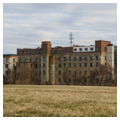You are here
The Mill at White Clay (Joseph Dean and Son)
On twenty riverfront acres north of the University of Delaware lies a brownfield redevelopment. An early grist mill (c. 1702, of which part of the race survives) burned in 1831 and was rebuilt. English-born Joseph Dean took over in 1845, converting the operation to spinning wool. He later expanded into the manufacture of Kentucky jeans, blankets, and Civil War military clothing. The company's Indigo Sky Blue Army Kerseys were famous, their “clear color and finish” attributed to crystalline White Clay Creek water. The mills burned in 1886. In the twentieth century, they were converted into a paper and vulcanized fiber mill. Following abandonment in the late 1980s, the polluted site was redeveloped as forty-eight apartments along with shops and offices, utilizing the old structures, including the tall, stuccoed-stone Main Building, which, in 1886, had been used for carding, spinning, and finishing, with fulling in the basement. Nearby stands a nineteenth-century neighborhood of former tenement houses for the mill workers.
Writing Credits
If SAH Archipedia has been useful to you, please consider supporting it.
SAH Archipedia tells the story of the United States through its buildings, landscapes, and cities. This freely available resource empowers the public with authoritative knowledge that deepens their understanding and appreciation of the built environment. But the Society of Architectural Historians, which created SAH Archipedia with University of Virginia Press, needs your support to maintain the high-caliber research, writing, photography, cartography, editing, design, and programming that make SAH Archipedia a trusted online resource available to all who value the history of place, heritage tourism, and learning.












